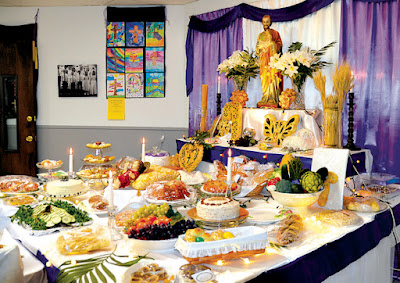2018 St. Joseph Table at St. Ann Parish, Excelsior Springs (Marty Denzer/Key photo)
This coming Sunday is St. Joseph’s Day (which is liturgically transferred to March 20th this year since it falls on a Sunday in Lent), but it is still an excellent time for us to have a festive meal in honor of St. Joseph. The following is quoted and adapted from The Year of St. Joseph Website.
The Feast of St. Joseph, which always falls in the middle of Lent, is especially commemorated and celebrated in Italy in general, and Sicily in particular, where St. Joseph has been long-regarded as the island’s Patron saint. It is there, among Sicilians, that the tradition of the “Tavola di San Giuseppe” or “St. Joseph’s Table” has its origins.
Since it is Lent, the meal is traditionally vegetarian, and we would do well to ensure that no meat is eaten at this meal, especially in our traditional Catholic churches and families.
What is served? There are two constants for the “table”: 1) there is no meat since it’s Lent and 2) the presence of sesame-coated bread in symbolic shapes. Breads, baked into symbolic shapes, are the centerpiece of the food table and the altar. The breads themselves are made from the same dough that forms traditional Italian bread and are often made into interesting and symbolic shapes for St. Joseph’s Day.
Other foods that are often present at more elaborate St. Joseph’s Table “feasts” include:
- Minestras, or very thick soups, are made of lentils, favas and other types of beans, together with escarole, broccoli or cauliflower. Other vegetables–celery, fennel stalks, boiled and stuffed artichokes–are also traditional.
- St. Joseph’s Day Pasta, also called Sawdust Pasta or Carpenter’s Pasta, made with bread crumbs sautéed in butter to resemble wood sawdust. Cheese isn’t used, symbolic of the food shortage experienced in the origin legend of the tradition.
- Sweet Pasta, a pasta dish made with honey.
- Olives, figs, and other side dishes.
As no feast is complete without dessert, no Saint Joseph’s altar would be finished without the flourish of sweet items. There are typically many cakes, biscotti, and cookies, many of which are embellished with almonds.
Two traditional desserts found at St. Joseph’s tables are sfingi–fried pieces of bread dough rolled in sugar—and zeppoli–a pastry shaped like a donut, fried or baked, and filled with a sweet pastry crème, then garnished with a dusting of powdered sugar and a maraschino cherry. Such items rose in popularity after eggs and dairy became widely permitted during Lent. Though it is possible to have vegan alternatives, in keeping with the traditional Lenten practice.




